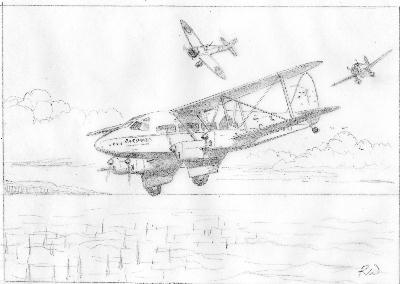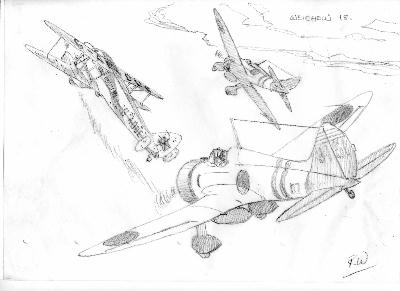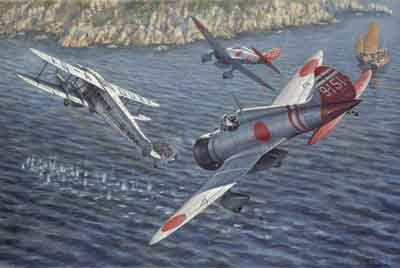|
|
|
One of the thrills and privileges of painting commissions is that I have often become party to recording and publicizing what has previously been unrecognized or unknown. This has been the case with many of my commissions depicting events during the recent conflicts over the former Yugoslavia and the Gulf, actions and scenarios which were clearly known only to the aircrews directly involved. But the following commission for The Weichow Incident has been delightfully different.... ...............................................................
“We are being fired on from the air……”
We left Kai Tak aerodrome at 22.58 GMT ( Greenwich date November 7th..o.) At 01.30 GMT our position was between seven and ten miles south of Waichow Island, having passed Fort Bayard at 00.58 GMT. Our height was 4,000 feet, visibility was good, more than 30 miles, and there was no cloud. I was at the controls, and Captain Wilson was entering the aforesaid position in his navigation log. Without any warning, there was a rattling noise at the machine, and we realised we were under fire. Captain Wilson took the controls, and I sent out the S.O.S signal, followed by the message “We are being fired on from the air.” After a few minutes, realising the impossibility of escape from our attackers, Captain Wilson turned the machine towards Wai Chow island, which by this time was north east of our position, and I sent another message to Fort Bayard - “Being forced to land at Wai Chow”. This was the last message I was able to send, as our altitude was insufficient to allow of the trailing aerial being used. So went the official report by First Officer J.F.Raeburn on Imperial Airways service HB183 on November 8th 1939( local date), flying the DH 86B Dardanus, G-ADUE, with Captain J.N.Wilson from Hong Kong to Bangkok. On board were just three passengers. This incident took place at a time when Britain was squaring up to the bully in her immediate neighbourhood, and was largely hushed up and eclipsed by subsequent events. Besides, quite miraculously nobody got hurt, and it seems it was the British airliner which had infringed the 15-mile security zone around the Japanese-held island in the Gulf of Tongking. The matter was finally resolved in 1961, when the Japanese government paid the UK a lump sum settlement for this and other incidents. Research When I first received the details of the commission from the client, who is a historian with the Hong Kong Historical Aviation Association resident in Britain, all the reference material that came with it was a handful of old Hong Kong newspaper clippings which, crucially, left us in the dark even about the fighter type involved. There was mention of Japanese Navy "seaplanes", which initially led us on a wild goose chase through the aviation literature. So little was known about this incident that I took the step of passing it to our Guild of Aviation Artists researcher John Blake, even though it was not a Guild commission. John went after it with typical gusto, and before long had turned up a whole pile of classified and previously unknown documents on the incident, including the official reports by the pilot and co-pilot in Hong Kong.....mainly from the depths of the (soon to be demolished) British Airways Archives at Heathrow Airport. The painting was constructed largely from the information in those reports. Once having identified the Mitsubishi A5M/Type 96 "Claude" as the culprit, the next challenge was getting adequate data on that ( to me) little-known plane. Quick recourse to the Web initially yielded only a handful of poor b/w shots, and a Russian 3-view plan which was not in good agreement with another from a book in my studio. A search for model kits of the plane( minimum 1/ 48 scale to be useful as a painting aid with such a small aircraft ) also had little luck. Several phone calls and e-mails to model suppliers resulted in nothing. But we had a lucky strike with a coloured profile from a Polish publication...illustrating a Japanese Navy Type A5M4 based on Weichow in 1940! And a more Internet-wise friend soon located an obscure Russian( I think) site displaying some close shots on the ground of what must have been a captured example of the fighter, suitably decorated in red stars. The other unfamiliar aircraft was the de Havilland DH86 Express, which at first sight looked like a larger and 4-engined version of the better-known Rapide. Which it essentially was( at 46 feet this 10-passenger airliner was shorter than a F-16! ). A drive down to the tiny shop at the De Havilland Heritage Museum ( locally known as the Mosquito Museum, as the banana-yellow Mosquito prototype is on display there) just outside my town of St Albans yielded a used copy of a little old book dedicated to that airliner. So for a mere £5 I got a bunch of b/w fossil photos and drawings of another extinct aeroplane. But again, thanks to Lady Luck! The family Readers' Digest Illustrated Atlas of the World noted Weichow Island (or Wai Chow, Wai Chao, etc.in the literature) as a speck someway off China's Hainan Island in the Gulf of Tongking, where a certain USN EP3 Orion had a similar enforced visit more recently. Google Earth was more helpful and managed to give something looking like a protozoan I used to know from my laboratory days. There were no indications of any present day airport/airstrip, but the little map showed a sheltered bay which must have been useful for the Japanese Navy, and at least I had the overall contours and rough dimensions of the place, in case that should become necessary for the painting. Composition The striking part of the account was the vigorous and skilful evasive manouevring by the pilot, taking the airliner down to some 50 feet over the sea and and turning for the island, and having at the last moment to pull up over the approaching cliffs. Due to his aerobatics, and the fact that the A5M ( unlike its successor the A6M Zero )had only light machine guns( firing through the engine cowling ) and no cannon, the airliner's plywood and fabric structure was riddled with bullet holes but survived the incident, along with everyone in it. The preliminary sketch ( Fig.1) was a fairly obvious first stab, emphasizing the DH86 skipping over the waves with the Claudes in hot pursuit, and would show its name....Dardanus.....on its nose. The immediate response of the client was that he preferred to have a view of the DH which would show not only the Union Jack emblem on its tail but also that on top of the fuselage between the wings. And those cliffs of Weichow Island as well somewhere in the background. And oh, please note it was a -B model, which had retrofitted "Zulu Shields" on the tailplanes. Back to the drawing board.....
Sketch Two(Fig 2) takes it from the fighters' perspective, but the area of the drawing taken up by the figure of the fighter worried the client: if I could "just make that fighter smaller and the airliner bigger in the picture....". Time to fight my corner......some persuasion was in order: It's not possible to have it both ways. There's no way to supercede the basic rules of perspective and have a sensible image. Those line drawings do not convey well depth/space and can often be misleading....etc. The skilful use of lighting can clearly be used in the painting to redress the balance. The event took place at about 9.30 am local time. An old favourite of mine....back or contre jour lighting.... could be used to advantage here. The morning sun from the right (east) could usefully put most of the near side of a pursuing A5M in shadow, while fully illuminating the topside of the jinking DH. As a sweetener a couple of old junks could be included on the waters below to set the scene, having in mind that the client is also an expert on Chinese sailing junks. In a word, trust the artist to do the job!
Painting I had not at the time anticipated a write-up on this painting, although there were ideas for using the painting to illustrate articles from the viewpoint of historical interest for one or two aviation periodicals here. So unfortunately I did not record stages of the work in progress( be thankful I had not thrown out the drawings!). But the procedure can hardly be anything new for readers of Aero Brush. The drawing and underpainting was rendered in Burnt Umber on to the 20 x 30 inch canvas and the basic tonal values set against a light background wash of Burnt Siena....Titanium White on the sunlit areas and washes of the Umber for the shadows. Colour and detail were then progressively developed on top of this acrylic underpainting using my habitually limited palette. The aircraft were initially drawn on to the fine canvas in pencil. Given that the available orthographic drawings in this case were of uncertain quality, and that it would in any case be impossible to dictate the precise standpoints of future viewers of the work, it was just as well to fall back on the old "free-hand", using our inborn perspective programs and the totality of the visual materials to do the job. Besides, I was in a hurry, and with other work ongoing in parallel, there was little time to clamber on to any putative giants' shoulders. I did have a little help from an old model of a Spitfire, which happens to have a surprising overall similarity of configuration to the Claude! It is a reminder that the thin elliptical wings we generally associate with the Spitfire was a known design option at that period of time....certain Heinkel designs also come to mind. The finished painting ( Fig.3 ) was delivered to the happy client in time, before his departure for Hong Kong. Judge for yourselves!
Fig.3: The Weichow Incident: 8 November 1939 Ronald Wong |


